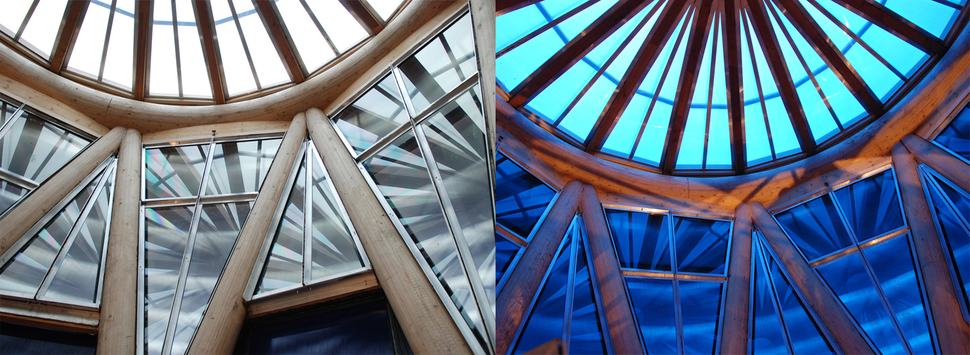A Suspended Particles window - on and off mode. (www.smartglass.com)
Cotemporary technological evolutions are now in service of the raising environmental conscience; new possibilities on daylight control, glare and heat exchange in buildings through dynamically switchable glazing technologies have arisen in order to provide more control on the working and living conditions. For those not familiar with the term, switchable glazing can reversibly modulate its total solar and/or visible transmittance properties in response to external stimuli like temperature or light intensity or by an electrically controlled switching.
The conventional daylight management strategies, such as louvres and other shading elements, are rather inefficient since their role is conflicting: natural lighting is desired to reduce the need for lighting energy, which in today’s buildings accounts for app. 30% of the total electricity demand, but daylight contains a lot of energy, i.e. heat, that is not always desired. Additionally, these strategies often involve considerable constructive effort, high investment costs, high maintenance and cleaning expenditures, while their architectural impact often does not meet the expectations of designers.
Switchable glazing on the other hand does not need any additional shading elements while it addresses the problem in a molecular level, using smart materials that change their properties under certain conditions. As a result, the solar radiation coming through the glass is better controlled, the energy demands are minimized, natural lighting is maximized while not sacrificing visual comfort, and architectural and aesthetic quality is achieved.
To have a quick introduction, some of the systems developed for switchable glazing are:
Electrochromic glass: It changes its colour or its transparency under an imposed electric current, to reflect the unwanted sunlight or to be used as a privacy modulator.
Liquid crystals glazing: It is based on a ‘Liquid Crystal Sheet’ placed between the sheets of glass and switches between transparency and translucence at the push of a button.
Suspended Particles: Small light-absorbing microscopic particles go from clear to dark in a matter of seconds providing privacy and blocking out light.
Photochromic glazing: It changes their transparency in response to light intensity and move from transparent to darker colour when exposed to light, and back to transparency when the light is dimmed or blocked.
Thermotropic glazing: It changes to a translucent, highly diffusing state, where both the reflected and the transmitted light are strongly scattered while below the switching temperature, the material is clear and transparent.
Thermochromic glazing: It reversibly changes its optical properties in response to a change in the surrounding temperature.
Polyarch coating: It is based on the Cholesteric Liquid Crystals properties and it is developed by TUDelft, TUEindhoven and the 3TULighthouse project. In warm days it can block the infrared radiation but transmit the visible light, meaning that solar heat is avoided while the glass remains totally transparent. In the “off” stage, the whole spectrum is transmitted through the glass.
Truth is all these technologies are still under experimentation and not all of them have reached the optimum stage in order to become available for massive production on the market, mostly due to the high production costs. However, goals have been set and their integration to building systems is a matter of time.
Source:
A. Kalatha, A. Kartsiou, A. Krousti. Smart Windows -Switchable Glazing Technology for Solar Control. Designer's Manual for the "Innovation and Sustainability" course, Building Technology, TU Delft. June 2015
